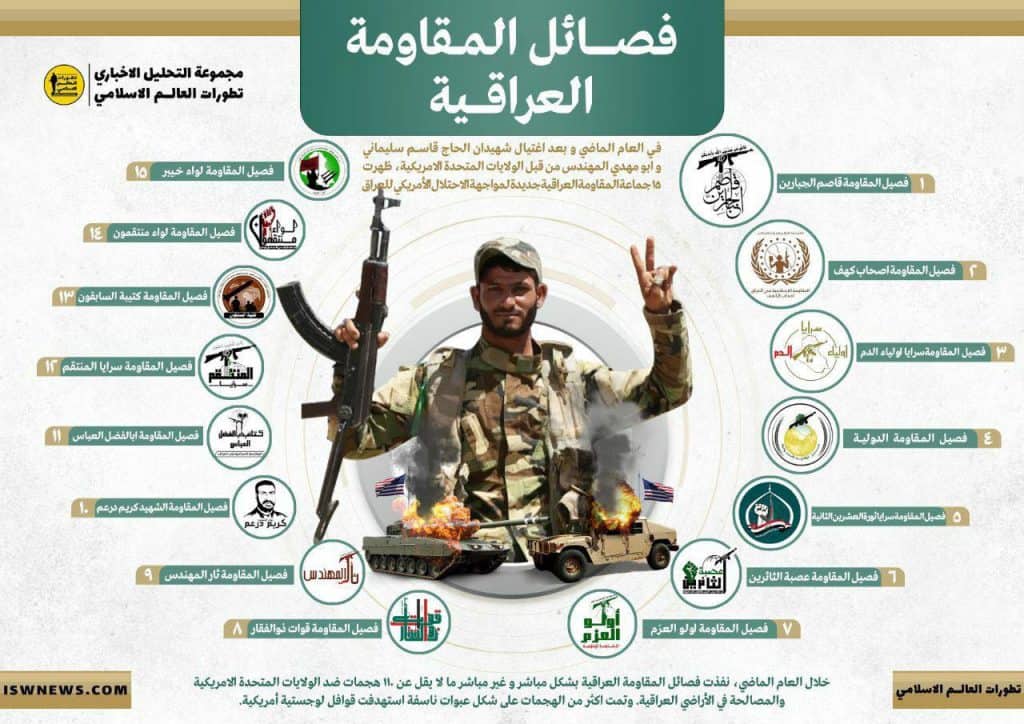
The so-called ‘Islamic Resistance in Iraq,’ a network of newer Iranian proxies, front groups, and other pro-Iranian actors, recently celebrated one year of activity against the U.S.-led coalition by touting the network’s operations. The infographic celebrating the activity makes note of which groups are within the network, in addition to also providing several interesting claims.
The infographic was released by a website affiliated to the Islamic Resistance and reposted to Telegram channels run by several of the groups themselves. The image notes that following last year’s assassinations of Iranian Islamic Revolutionary Guard Corps General Qassem Soleimani and Kata’ib Hezbollah leader Abu Mahdi al-Muhandis, “15 new Iraqi resistance groups emerged to confront the American occupation of Iraq.”
It then proceeds to list the 15 groups, which includes many that have previously been covered by FDD’s Long War Journal including: People of the Cave, Zulfiqar Forces, Avenger Brigades, Guardians of the Blood Brigades, League of the Revolutionaries, and the Revenge of Muhandis Brigade.
Other units, such as Al-Fadl al-Abbas Brigades, Katibat al-Sabiqun, and Liwa al-Khaybar, were also included within the list. Every group included within the infographic has claimed at least one attack against either the Iraqi state, U.S. or other international forces, or U.S.-contracted logistical supply companies.
The infographic makes note of this by claiming that in its first year of existence, the Islamic Resistance was “directly and indirectly responsible for no less than 110 attacks against the United States of America and its interests in Iraqi land.” It goes on to state that “and several of the attacks were in the form of IEDs targeting American logistical convoys.”
That said, many of the assaults claimed by these outfits are hard to corroborate. In other instances, the groups have misrepresented strikes to appear as if American forces were indeed targeted. In some examples, dates and locations do not match with what was reported in local media, casting further doubt on the militias’ claims.
Other operations, however, have been confirmed. This includes:
On March 14, 2020 two U.S. personnel and one UK soldier were killed in a rocket barrage against Camp Taji. Not long after, a group calling itself “League of the Revolutionaries” emerged to take credit for the strike, beginning its campaign against Coalition troops in Iraq.
On June 11, 2020 “League of the Revolutionaries” claimed responsibility for the attack against the U.S. Embassy in Baghdad.
Additionally, “League of the Revolutionaries” claimed responsibility for the June 16, 2020 rocket attack near the Baghdad Airport. According to local reports, two rockets struck near the Baghdad Diplomatic Support Center with no casualties being involved.
On Sept. 15, 2020 at least one IED targeted British diplomatic vehicles while they were traveling between Baghdad’s Green Zone and the airport. The convoy was reportedly returning from dropping off a British diplomat at the airport when the attack occurred.
Later that day, yet another newly-formed group, the Avenger Brigades, claimed responsibility for the assault in a statement released online, alleging that two IEDs were used.
As previously documented by FDD’s Long War Journal, these purporported groups form part of an extensive propaganda campaign orchestrated by Iran and its allies against the United States in Iraq.
Almost all of these new outfits utilize logos similar to that of Iran’s Islamic Revolutionary Guard Corps, showing a degree of transparency that these units are part of Iran’s network. Many are likely just fronts for larger, more established Iranian proxies inside the country.
By utilizing allegedly new local units to conduct attacks against U.S. forces, Iran and its veteran Iraqi proxies are afforded several degrees of separation and therefore more plausible deniability in their operations. This tactic has long been used by Iran inside the Middle East and beyond to conduct more sensitive attacks.
At the same time, other alleged militias within the so-called ‘Islamic Resistance in Iraq’ are possible fabrications meant to create a narrative of a large movement opposed to the presence of American troops.
By creating this image, Iran can help further sow distrust and confusion against U.S. troops in Iraq as well as portray to outsiders that their presence is largely opposed. In both cases, this furthers Iran’s goal of ejecting the U.S. from Iraq.







